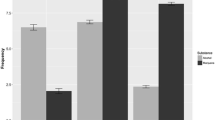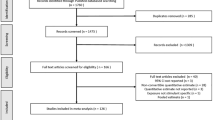Abstract
To better understand and control the spread of sexually transmitted diseases among high-risk youth, we must first acquire reliable reports of sexual risk behavior. This study evaluates one potential method for validating such reports. We examined the association between marijuana and cocaine use reporting patterns and the number of reported recent sexual partners in a sample of juvenile arrestees/detainees. Using urinalysis to validate self-reported drug use, we categorized drug use reporting patterns into four groups: overreporters, underreporters, honest users, and honest nonusers. Analyses showed, in general, that overreporters reported more sexual partners than either underreporters or accurate reporters, suggesting that overreporters of drug use may also exaggerate sex partner reports. Findings suggest a new method for validating self-reported sexual behavior and provide a challenge to theories of juvenile delinquency.
Similar content being viewed by others
REFERENCES
Aquilino, W. S., and LoSciuto, L. (1990). Effects of interview mode on self-reported drug use. Publ.Opin.Q.54: 362–395.
Boekeloo, B. O., Schiavo, L., Rabin, D. L., Conlon, R. T., Jordan, C. S., and Mundt, D. J. (1994). Selfreports of HIV risk factors by patients at a sexually transmitted disease clinic: Audio vs written questionnaires. Am.J.Public Health84(5): 754–760.
Catania, J. A., Gibson, D. R., Chitwood, D. D., and Coates, T. J. (1990a). Methodological problems in AIDS behavioral research: Influences on measurement error and participation bias in studies of sexual behavior. Psychol.Bull.108: 339–62.
Catania, J. A., Binson, D., Canchola, J., Pollack, L. M., Hauck,W., and Coates, T. J. (1996). Effects of interviewer gender, interviewer choice, and item wording on responses to questions concerning sexual behavior. Publ.Opin.Q.60: 345–375.
Catania, J. A., Gibson, D. R., Marin, B., Coates, T. J., and Greenblatt, R. M. (1990b). Response bias in assessing sexual behaviors relevant to HIV transmission. Eval.Prog.Plan.13: 19–29.
Chaiken, J. M., and Chaiken, M. R. (1993). Understanding the Drug Use Forecasting (DUF) Sample of Adult Arrestees, National Institute of Justice, Lincoln, MA.
Fendrich, M., and Xu, Y. (1994). The validity of drug use reports from juvenile arrestees. Int.J.Addict.29: 971–985.
Gibson, D. R., and Young, M. (1994). Assessing the reliability and validity of self-reported risk behavior. In Battjes, R. J., Sloboda, Z., and Grace, W. C. (eds.), The Context of HIV Risk Among Drug Users and Their Sexual Partners, National Institute on Drug Abuse Research Monograph 143, NIH Publ. No. 94–3750, National Institute on Drug Abuse, Rockville, MD.
Grella, C. E., Chaiken, S., and Anglin, M. D. (1995). A procedure for assessing the validity of selfreport data on high-risk sex behaviors from heroin addicts entering free methadone treatment. J.Drug Issues25(4): 723–733.
Hedeker, D., and Gibbons, R. (1994).Arandom-effects ordinal regression model for multilevel analysis. Biometrics50: 933–944.
Hedeker, D., and Gibbons, R. (1996). MIXOR: A computer program for mixed-effects ordinal regression analysis. Comput.Methods Programs Biomed.49: 157–176.
Huber, P. J. (1967). The behavior of maximum liklihood estimates under non-standard conditions. Proceedings of the Fifth Berkeley Symposium in Mathematical Statistics and Probability, 1, University of California Press, Berkeley, CA.
Jessor, R., and Jessor, S. L. (1977). Problem Behavior and Psychosocial Development: A Longitudinal Study of Youth, Academic Press, New York.
Johnson, T. P., Fendrich, M., Sudman, S., Wislar, J. S., and Severns, E. (1999). An experiment to improve drug use reports during survey interviews. 1998 Proceedings of the Section on Survey Research Methods, American Statistical Association, Alexandria, VA, pp. 888–893.
Johnston, L. D, O'Malley, P. M., and Bachman, J. G. (1998). Monitoring the Future 1998 Data Tables/Figures[online]. Available: Http://www.isr.umich.edu/src/mtf.
Kirk, J., and Miller, M. L. (1986). Reliability and Validity in Qualitative Research, Sage University Paper Series on Qualitative Research Methods, Vol. 1, Sage, Beverly Hills, CA.
Lowry, R., Holtzman, D., Truman, B. I., Kann, L., Collins, J. L., and Kolbe, L. J. (1994). Substance use and HIV-related sexual behaviors among US high school students: Are they related? Am.J.Public Health84: 1116–1120.
Measham, F., Parker, H., and Aldridge, J. (1998). The teenage transition: From adolescent recreational drug use to the young adult dance culture in Britain in the mid-1990's. J.Drug Issues28(1): 9–32.
Metzler, C. W., Noell, J., and Biglan, A. (1992). The validation of a construct of high-risk sexual behavior in heterosexual adolescents. J.Adolesc.Res.7(2): 223–249.
National Institute of Justice (1996). 1995 Drug Use Forecasting Annual Report on Adult and Juvenile Arresstees, National Institute of Justice, Washington, DC.
Nunnally, J. C., and Bernstein, I. H. (1967). Psychometric Theory, McGraw-Hill, New York.
Romer, D., Hornik, R., Stanton, B., Black, M., Li, X., Ricardo, I., and Feigelman, S. (1997). “Talking” computers: A reliable and private method to conduct interviews on sensitive topics with children. J.Sex Res. 34(1): 3–9.
Schopper, D., Doussantousse, S., and Orav, J. (1993). Sexual behaviors relevant to HIV transmission in a rural African population. Soc.Sci.Med.37(3): 401–412.
Seidman, S. N., and Rieder, R. O. (1994). A review of sexual behavior in the United States. Am.J.Psychiatry151(3): 330–341.
StatCorp (1997). Stata Statistical Software: Release 5.0, Stata Corporation, College Station, TX.
Turner, C. F., Ku, L, Rogers, S. M., Lindberg, L. D., Pleck, J. H., and Sonenstein, F. L. (1998). Adolescent sexual behavior, drug use, and violence: Increased reporting with computer survey technology. Science280(5): 867–873.
Udry, J., and Morris, N. (1967). A method for validation of reported sexual data. J.Marriage Family29(3): 422–446.
Visher, C. (1991). A Comparison of Urinalysis Technologies for Drug Testing in Criminal Justice, National Institute of Justice and the Bureau of Justice Assistance, Washington, DC.
Weinhardt, L. S., Forsyth, A. D., Carey, M. P., Jaworski, B. C., and Durant, L. E. (1998). Reliability and validity of self-report measures of HIV-related sexual behavior: Progress since 1990 and recommendations for research and practice. Arch.Sex.Behav.27(2): 155–180.
White, H. (1980). A heteroskedasticity-consistent covariance matrix estimator and a direct test for heteroskedasticity. Econometrica48: 817–830.
White, H. (1982). Maximum liklihood estimation of misspecified models. Econometrica50: 1–25.
Author information
Authors and Affiliations
Rights and permissions
About this article
Cite this article
Wislar, J.S., Fendrich, M. Can Self-Reported Drug Use Data Be Used to Assess Sex Risk Behavior in Adolescents?. Arch Sex Behav 29, 77–89 (2000). https://doi.org/10.1023/A:1001838605520
Issue Date:
DOI: https://doi.org/10.1023/A:1001838605520




